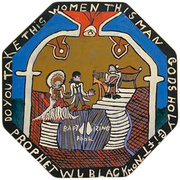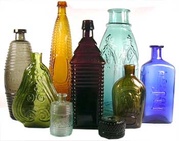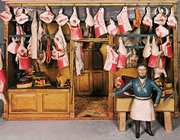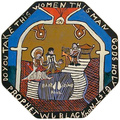
A European bottle whimsey featuring a miniature golden chair in a bottle with a pontil mark and a locking stopper, c. 1890-1900. Photo courtesy Susan D. Jones.
As the world has slowed to a crawl because of global orders to shelter-in-place, billions of humans are living in a much-reduced footprint, often confined within the walls of their own homes. For those of us used to busy lives full of social activities, it’s a bit like being sealed inside a bell jar, or perhaps a large glass bottle—our lives go on, but their framing has drastically changed. A century ago, during times like this, self-taught craftspeople might have spent this required time at home making bottle whimseys, or miniature sculptures and scenes built entirely within empty bottles.
“I have always had dollhouses, and looking at these little scenes was like looking into a dollhouse.”
In the late 19th and early 20th centuries, as bottles became an abundant and disposable resource used to package liquor, medicine, food, cleaning products, and more, a subset of folk artists began using these discarded glass containers as stages for their miniature sculptures. Beginning with petite religious shrines made in Europe, the trend spread to the United States and encompassed a wide range of subjects. Most people today are familiar with the common novelty of a ship-in-a-bottle, but few have seen the true variety of bottle whimseys or puzzle bottles that were made, ranging from multi-level coal-mining miniatures to bawdy bar scenes, many featuring complex decorative stoppers in place of a standard cork.

This bottle whimsey depicting the offices of the Berghoff Brewing Co. was made by Carl Wörner, c. 1919. Photo courtesy Susan D. Jones. (click to enlarge)
Regardless of the subject matter, bottle whimseys have an innate appeal, due to their almost-magical unseen assembly process: Just how does one fit an elaborate wooden chair or boat or crucifix through an opening smaller than a quarter?
Susan D. Jones, author of Genius in a Bottle: The Art and Magic of Bottle Whimseys, explains that the term “whimsey” (sometimes spelled “whimsy”), simply describes a variety of small ornaments, doodads, curios, or whatever-you-call-them made by folk artisans. “Whimseys originated as nonfunctional articles made by craftsmen, and they were usually men, showing their skill,” Jones says. The result was a smorgasbord of little decorative trinkets made by metalworkers, glassblowers, potters, and woodworkers.
In Jones’ book, she writes that the spread of bottle whimseys in the United States is owed to a convergence of three trends in the late 19th century: “craftsmen with whittling skills and the leisure time to create, the mass production and ready availability of clear glass bottles, and earlier examples from various European traditions to inspire imitation and innovation.” Jones explains that there were four primary motifs seen in European bottle whimseys that became the basis for this form of folk art—religious scenes, mining scenes, spinning or weaving tools, and ships in bottles.
The art of bottle whimseys appears to have gotten its start in Germany with religious miniatures. From there, the trend spread across Europe and the United States. “I have seen very early shrines built by German nuns and monks with carved crucifixes and surrounding tools, but not put into a bottle,” Jones says. “They have three sides and a bottom, and a crucifix in the middle surrounded by what they call ‘instruments of the passion.’”

This surprisingly pristine crucifixion scene is inside a very large bottle with a locking stopper, possibly c. 1910-20. Photo courtesy Susan D. Jones. (click to enlarge)
Whether made in Europe or the United States, religious bottle whimseys often mirrored this approach, with a central crucifix flanked by iconic Biblical objects.

An early two-level mining bottle made by Matthias Buchinger (also called Matthew Buchinger), who was born without hands and feet, c. 1719. Photo courtesy Alan Rogers. (click to enlarge)
“The tools included a hammer and nails, a spear, a pole with what’s meant to be the sponge with vinegar, and a ladder,” Jones says. “But later, they included pick axes, shovels, and pliers. Different makers added INRI banners, doves, lanterns, cloth representing Jesus’s clothes, and even angels and soldiers.
“The ones that originate in Germany,” Jones continues, “if they have a Jesus at all, almost always have paper Jesuses on the cross, either cut from a prayer card or drawn on paper. This is almost never the case with American ones.”
However, the first bottle whimseys weren’t limited to religious iconography: Other early artworks include Matthias Buchinger’s 8-inch tall bottle featuring a two-level mine and mechanical mill, and J. C. Held’s elaborate sculpture of a stocking weaver at his loom, both circa 1719.

The paper label inside the bottle made by Buchinger. Photo courtesy Alan Rogers.
While the earliest-known bottle whimseys date to the mid-18th century, the art form really began to take off once glass bottles were mass produced and easily procured.

A stocking weaver at his loom in a bottle with a locking stopper made by J.C. Held, c. 1719. Photo via the Stadtmuseum, Erlangen, Germany. (click to enlarge)
“The vast majority of whimseys date from after 1900, even 1910,” Jones explains. “They didn’t become something everyday people could make until bottles became common and thought of as disposable. My guess is that the first disposable small bottles were patent medicine bottles; so many of my older bottles are stamped with the name of a drugstore.”
After the Civil War, handmade bottle whimseys became more popular in the United States and the themes expanded from the craft’s European roots: Some showcased Masonic or fraternal objects, wishing wells, farm or household tools, elaborate whittled fans, and other general whimsies. As Jones writes in her book, “A growing and mobile population of laborers spread the art form through contacts on the job, in the Army and Navy, in prison, and by the late 19th century, through the hobo communities connected by river, road and rail. Houses, intricate interlocking wooden puzzles, shops and saloons and brothels, fans and birds, framed pictures and memorials, tools, chairs, and wishing wells all became the subjects of this folk-art expression.”
“I think the yarn winders and niddy noddies and spinning wheels were popular because they are difficult to make and wind,” Jones says. “The kinds with different levels of spokes coming out from the center, wound with thread around them and sometimes with beads, are very challenging. So there is an extra ‘gee whiz’ factor. And yarn winders were something many people had at home to copy from.”

Left, a complex multi-level yarn winder hung with bobbins wrapped in silk thread, c. late 19th century. Photo courtesy Valerie and Matthew Young. Right, a yarn-winder whimsey used to advertise the various services of William S. Scobey of Syracuse, New York, c. 1900. Photo courtesy Susan D. Jones. (click to enlarge)
Bottle whimseys offered a novel way to present familiar sights and objects, like those depicting the tools and machinery used for ore mining in the late 19th century. “I’m not sure why mining bottles came to be made, but it could have been prompted by a town or a mining guild which had one made for their town or guildhouse,” Jones supposes.
“They consist of either three or four levels, depending on the size of the bottle. On the bottom level, miners are digging coal or ore. Sometimes it is actually sparkly material. The next level up, miners are sorting coal, often on what looks like conveyor belts but which are obviously surfaces for washing. If there are four levels, there is sometimes a big oven where they are smelting the ore. The top level is often a town council meeting, or something with dignitaries. A marching band is a common feature, too.” A few mining bottles even included mechanical cranks to turn the machinery inside them.

A German mining bottle from the early 19th century. Photo courtesy Susan D. Jones. (click to enlarge)
“The mining bottles were always rectangular, and may have been decanters for spirits,” she adds. “The one I own has carved details along the edges of the bottle, clearly not a mass-produced thing.” During the 18th and early 19th centuries, bars would often have their liquor delivered in barrels, which they would decant into large glass bottles—about 17” tall with room for a gallon of liquor—to serve customers from. These spacious clear bottles were perfect for constructing bottle whimseys.
While chronologically parallel, the trend for building little ships inside bottles has since become more mainstream than other folk-art whimseys. Most ships-in-a-bottle were actually realistic scale models of ships that eventually inspired an industry of how-to books and kits.

A model ship in a glass orb made by captain Giovanni Biondo in 1784. Photo via the Museum für Kunst und Kulturgeschichte, Hansestadt Lübeck.
“The earliest ship in glass, which is not really a bottle, that we know of is in a museum in Europe,” Jones says. “It’s in a big glass bubble, full rigging.” Created in 1784 by Venetian sea captain Giovanni Biondo, this miniature ship built in a blown-glass oval and mounted on a wooden stand is now in the collection at the Museum für Kunst und Kulturgeschichte, Hansestadt Lübeck. “Ships in bottles were rarely made on ships since bottles were scarce on board, but they were popular subjects after 1900,” she adds. According to Jones, the creation of “ships-in-a-bottle” really took off after “Popular Mechanics” began holding contests for these miniature replicas in the first half of the 20th century.
Although bottle whimseys derive much of their appeal from the seeming impossibility of their creation, the craft is rather straightforward: A whimsical miniature sculpture or carving was made to fit inside a certain bottle and then dismantled, its parts slid inside the glass container beginning with its largest pieces. Segments of wire with hooked ends were used to maneuver the pieces into place, where they were glued or fitted together. Other items, like chairs or framed pictures, were made to be flattened or rolled up and then expanded once inside their glass cage.
The objects inside of bottle whimseys were typically made from wood, though paper, fabric, and other common materials were also used. To literally top it all off, artisans often created ingeniously carved bottle stoppers to finish their work. “The more collectible ones have carved locking stoppers, and the fake ‘lock’ is always impressive,” Jones says. “A simple cross piece is easy to figure out, but I have one that has three levels of fake locking devices. I have no idea how it could’ve been made, and it’s tiny to boot.”

This complex display of several wooden fans was given to a judge by a prisoner, c. 1904. Photo courtesy Susan D. Jones. (click to enlarge)
“Most of the common whittling ‘tricks’ like chains, scissors, balls in cages, and pen knives made from single pieces of wood were put on stoppers outside of the bottle,” Jones continues. “Daniel Rose—circa late 1890s to 1920—put working scissors inside bottles, and I’ve seen working pliers inside bottles. The one common whittled subject inside bottles is the fan, carved from a single piece of wood and opened inside the bottle.”
Many of these decorative wooden whimseys are incredible because their pieces could only have been formed from a single scrap of lumber. “Stoppers with whittled whimseys, like chains or balls in cages are always impressive,” Jones says. “I have one with a fist holding a stirrup with chains and pen knives at the end dangling from the stirrup. It almost has to be one single piece of wood. I have several towers, one with four pillars, four cannons, and a tower with a cross on top; the edge is inlaid with two colors of wood. The ‘Book in Hand’ artist’s stoppers have a hand holding an open book. They’re beautiful.”

Left, a wooden house with an elaborate stopper in the shape of a hand with a stirrup, chains, and folding knife, signed Eliot A. Burlingame, Lansing, Michigan, c. 1880. Right, a bottle filled by a decorative wishing well is topped with a hand holding a book made by an artist thought to be a Civil War veteran, c. 1890s. Photos courtesy Susan D. Jones.
In the United States, most bottle-whimsey artists are unknown, as they didn’t sign their work and were never made famous by it. However, research has identified a few bottle-whimsey craftsmen, such as Carl Wörner (sometimes spelled Karl Worner), a folk artist who often hid a figure under the floor of his bottle scenes.

This scene at the Dan Eppler Saloon includes a hidden figure under the floor and was carved by Carl Wörner, c. 1900-1910. Photo courtesy Susan D. Jones. (click to enlarge)
“Wörner, circa 1860-1930, was very prolific and very recognizable,” Jones says. “He started with crucifix bottles and is most known for bar and other shop scenes in bottles. He even did a funeral home in a bottle. The only bottle whimseys I know that were made for payment were Wörner’s—he paid bar bills with them and bought shoes and food with them.”
Though Jones has heard of a few whimsey bottles displayed in public places, it’s likely most were kept in private homes by the artists themselves or those who were gifted or purchased them. “I assume Wörner’s bar bottles were displayed prominently at the bars,” Jones says, “and I know one of his shoemaker bottles was displayed at the shoe shop. Ones made for someone as a gift were most likely displayed in their home.
“Wörner was self taught, I’m sure, but others learned the craft from people who already did it—at hobo camps, prisons, veterans’ homes,” she adds. “A very recognizable chair-bottle form was made by several residents of the Odd Fellows’ Home in Liberty, Missouri, in the 1920s. And I’ve seen several bottles made by prisoners that follow almost the exact same form. I’m sure the art was passed around, but others must have figured it out on their own.” Other known whimsey-makers include Daniel Rose and Adam Selick, both of Pennsylvania; “The Caveman” of Branson, Missouri; the “Book in Hand” artist of Vermont; and Thomas Edwards from Dayton, Ohio, who made little ships inside glass flasks. Multiple bottles have been identified as the work of each of these artists.

A tiny ship in a pumpkinseed flask with a banner commemorating Ohio Governor Joseph Benson Foraker, c. 1886-1890. This whimsey bottle was made at the Soldier’s Home in Dayton, Ohio, a home for disabled veterans of the Civil War. Photo courtesy Susan D. Jones.
In fact, it was a Wörner bottle purchased by her folk-art dealing brother that sent Jones down the rabbit hole of bottle whimseys in the first place. “I have always had dollhouses, and looking at these little scenes was like looking into a dollhouse,” Jones says. “My brother let his fellow dealers know I wanted them, and they all helped build my collection. In those days, you could also find great ones on eBay.
“I think Wörner’s funeral home with two undertakers and a casket with a body in it might be one of the most unusual,” she continues. “I don’t own it; wish I did. A Wörner rarity, but by no means unique, is what he called ‘The Happy Home.’ A dining-room table and a family seated around the table, usually a baby in a high chair too. My favorite that I own is a Wörner chicken-and-egg store, ‘Bill’s Place,’ which is two levels deep (a room behind the front room) and shows a woman buying something, crates of eggs around the shelves, crates with chickens’ heads poking out between the slats on the floor.”
Despite these standout examples, the vast majority of bottle whimseys featured much simpler sculptures inside—something a person with limited woodworking skills might be able to put together without much instruction. Their popularity widely subsided as the United States pulled out of the Great Depression in the 1930s and more folks found full-time jobs, reducing free time and increasing discretionary income. Perhaps during this surreal moment in 2020, with a global recession and public-health demands to stay indoors, some of us stuck at home because of COVID-19 will learn to build our own little worlds inside empty glass bottles.

Left, a colorful chair whimsey, c. 1930s-1940s. Right, a memorial bottle featuring a framed photograph with an inscription on the reverse marked December 25, c. mid-19th century. Photos courtesy Susan D. Jones.
(For more on bottle whimseys, check out Susan D. Jones’ website here. If you buy something through a link in this article, Collectors Weekly may get a share of the sale. Learn more.)

 Bill Lindsey on How To Read a Bottle
Bill Lindsey on How To Read a Bottle
 Homespun Beauty: Jim Linderman on Folk Art’s Authentic Appeal
Homespun Beauty: Jim Linderman on Folk Art’s Authentic Appeal Bill Lindsey on How To Read a Bottle
Bill Lindsey on How To Read a Bottle Baby's First Butcher Shop, Circa 1900
Baby's First Butcher Shop, Circa 1900 Bottle WhimseysBottle whimseys, also called whimsey bottles or puzzle bottles, are a form …
Bottle WhimseysBottle whimseys, also called whimsey bottles or puzzle bottles, are a form … BottlesLike modern glassware, ancient bottles relied on three basic ingredients: S…
BottlesLike modern glassware, ancient bottles relied on three basic ingredients: S… Folk ArtFolk art is a catch-all term used to describe paintings, sculptures, and te…
Folk ArtFolk art is a catch-all term used to describe paintings, sculptures, and te… Mari Tepper: Laying it on the Line
Mari Tepper: Laying it on the Line Nice Ice: Valerie Hammond on the Genteel Charm of Vintage Canadian Costume Jewelry
Nice Ice: Valerie Hammond on the Genteel Charm of Vintage Canadian Costume Jewelry How Jim Heimann Got Crazy for California Architecture
How Jim Heimann Got Crazy for California Architecture Modernist Man: Jock Peters May Be the Most Influential Architect You've Never Heard Of
Modernist Man: Jock Peters May Be the Most Influential Architect You've Never Heard Of Meet Cute: Were Kokeshi Dolls the Models for Hello Kitty, Pokemon, and Be@rbrick?
Meet Cute: Were Kokeshi Dolls the Models for Hello Kitty, Pokemon, and Be@rbrick? When the King of Comedy Posters Set His Surreal Sights on the World of Rock 'n' Roll
When the King of Comedy Posters Set His Surreal Sights on the World of Rock 'n' Roll How One Artist Makes New Art From Old Coloring Books and Found Photos
How One Artist Makes New Art From Old Coloring Books and Found Photos Say Cheese! How Bad Photography Has Changed Our Definition of Good Pictures
Say Cheese! How Bad Photography Has Changed Our Definition of Good Pictures Middle Earthenware: One Family's Quest to Reclaim Its Place in British Pottery History
Middle Earthenware: One Family's Quest to Reclaim Its Place in British Pottery History Fancy Fowl: How an Evil Sea Captain and a Beloved Queen Made the World Crave KFC
Fancy Fowl: How an Evil Sea Captain and a Beloved Queen Made the World Crave KFC
I wanted to know it you have heard of a folk artist call The Caveman Branson MI, I think he was there in the 1940’s have you any information on him or do you know anyone that does
… not only did I get an education of commercial glass and the art of whimseys,… as a boomer…, I realized that “shadow boxes” are the later grand-children. A great subject that was well told, I learned some things !
We are now the custodians of a bottle that has been in the family for many generations. It is a religious scene. Our relative had a prison ministery and it was carved by a prisoner in the late 1800’s. How do you seal them? It looks dusty. Or is it the quality of the bottle?